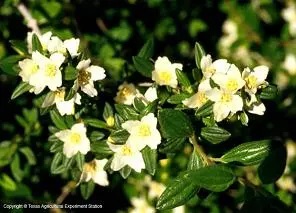NICE! Plant of the Month
(Philadelphus ernestii or Philadelphus texensis)

Family: Hydrangeaceae, Saxifragaceae
Type: Shrub; 1-3 feet, much-branched, slender stems, peeling bark.
Natural Habitat: Endemic to Texas Hill Country.
Preferred Site and Use: Moist shady canyon or bluff walls.
Deer Resistance: Readily browsed.
Wildlife: None noted.
Light Tolerance: Partial shade.
Flowers: Delicate, white, fragrant, showy, ¾”, April-May.
Fruit: Small round capsule, persistent, with many black seeds.
Leaves: Simple, opposite, slender, deciduous, 1″, 3-nerved.
Water Requirements: Moderate
Soil Requirements: Calcareous or igneous, well drained.
Maintenance: Protect from deer.
Planting Instructions: Dig a hole two to five times wider than but the same depth as the root ball in the nursery container. Sides of the hole should be irregular, not smooth. Remove plant from container, taking care to support the root ball. Loosen exterior roots gently with your fingers. If the plant is root-bound and cannot be loosened by hand, the outer roots may be cut in several places. Lift the plant by the root ball and place into the hole. Backfill hole, using soil that was dug out or mix no more than 15-20 % organic matter into backfill soil. Do not add any soil to the top of the root ball, but a thin layer of compost may be spread over the soil surface. Gently firm the soil with your hands, but do not tamp it down. Place 3-4 inches of mulch over the bare soil around and over the root ball, but not touching the base of the plant stem.
Watering Instructions: Water deeply after planting to settle soil around roots. Then water every 7-10 days, as needed, during the first growing season. Before watering, check for soil moisture at a depth of an inch or two at the edge of the root ball. Skip a watering when moisture is adequate or after a rainfall of ½ to 1 inch. Maintain this watering schedule until the first fall. Reduce watering during the cool fall and winter months. In a “normal” year, no watering may be necessary during the first fall and winter, but during a dry period, monthly watering may be needed. Second Spring and thereafter water monthly only during periods of drought. Once established, natives will survive with little supplemental irrigation.
NICE! Tip: Use this bright, small shrub in shady moist locations or where moisture can be provided. Due to deer overpopulation and heavy browsing this plant is currently on the “Species of Concern” list in Texas. It needs reintroduction into appropriate habitat and protection from browsing to ensure its continued existence. Help save a rare plant!
Look for the NICE! Plant of the Month signs and information sheets on your next visit to a participating Boerne nursery. And thank you for supporting native plants by using them in your landscapes.


